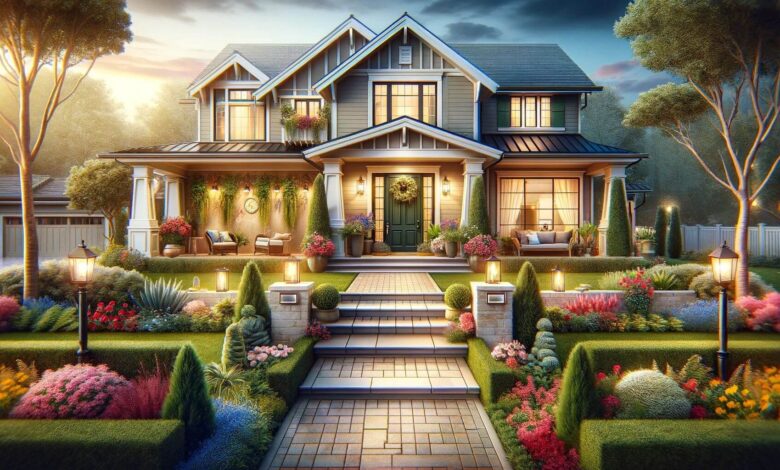Boost Your Home’s Curb Appeal With Landscaped Gardens

First impressions are vital, particularly when it comes to your home. Imagine driving through a neighborhood where every house has a beautifully landscaped front yard—that’s the power of curb appeal. A lush, well-maintained garden isn’t just a feast for the eyes; it can significantly enhance your property’s value. Many homeowners start by visiting a landscaping supply store to gather the perfect elements for their garden. According to a report by HGTV, a well-maintained garden can boost your home’s value by up to 20%. Investing in your garden can yield substantial returns when it comes time to sell.
Curb appeal isn’t solely for potential buyers, however. A well-maintained garden elevates the aesthetics of the entire neighborhood, fostering a sense of community and shared pride among residents. Moreover, it significantly enhances your enjoyment of your home. Picture coming back from a long day at work to a tranquil, beautifully landscaped garden that reflects your unique personality and style. Simple touches like vibrant flower beds, neatly pruned shrubs, and strategically placed garden décor can transform your home’s exterior into a welcoming sanctuary.
Choosing the Right Plants
Choosing the right plants for your garden is an art and a science. Understanding your local climate and soil type ensures your plants thrive. Opting for native flora is an intelligent choice, as these plants are adapted to your region’s specific conditions and typically require less care than non-native species. For instance, drought-tolerant plants like succulents and cacti can be a godsend in arid climates, providing beauty without excessive water needs.
Additionally, consider the seasonal blooming patterns of various plants to create a garden that looks great year-round. Strategically selecting plants to bloom in different seasons guarantees that your garden remains vibrant and colorful throughout the year. Factors to consider include the plant’s hardiness zone, water requirements, and sun exposure. Whether lining your pathways with aromatic lavender or planting a majestic oak tree in your front yard, your choices will shape your garden’s overall ambiance and sustainability.
Factors to Consider:
- Climate: Choose plants suited to your local weather conditions to minimize maintenance and increase longevity.
- Soil Type: Understanding your soil composition is crucial. Some plants thrive in sandy soil, while others prefer loamy or clay-rich soil.
- Water Requirements: Select plants that align with your ability to water them regularly. Drought-resistant plants are excellent for those with busy schedules or water restrictions.
Essential Landscaping Elements
A well-designed garden seamlessly combines various elements like trees, shrubs, flowers, and hardscaping features. Essential landscaping elements can transform an ordinary yard into an extraordinary outdoor space that impresses and inspires. Key elements such as water features or garden paths enhance the garden’s appearance and functionality. For instance, a winding stone pathway can lead guests on a charming journey through your garden, while a koi pond can become a tranquil focal point where you can relax and unwind.
Beyond aesthetics, landscaping elements are functional. Trees and shrubs offer structure and privacy, while flowers add bursts of color and fragrance. Hardscaping features like retaining walls, terraces, and decorative stones lend texture and dimension to your garden. Don’t overlook the importance of lighting—well-placed garden lights can create a magical ambiance during the evening, highlighting your garden’s best features and ensuring safety for nighttime strolls. Thoughtfully selecting and arranging these elements will create a cohesive and inviting outdoor space.
Important Elements Include:
- Trees and Shrubs: Offer structure, shade, and privacy, creating a natural framework for your garden.
- Flowers: Provide vibrant colors and delightful fragrances, enhancing the sensory experience of your garden.
- Hardscaping: Features like paving stones, decks, and water fountains add texture and functional beauty to your garden.
- Lighting: Outdoor lighting enhances safety and ambiance, transforming your garden into a captivating evening retreat.
Environmental Benefits
Landscaped gardens offer more than just aesthetic value; they provide numerous environmental benefits that contribute to a healthier ecosystem. One of the most significant advantages is reducing urban heat. Green spaces naturally cool the environment, counteracting the heat island effect common in urban areas. Additionally, plants improve air quality by filtering pollutants and producing oxygen, creating a cleaner and healthier atmosphere.
Landscaped gardens also support local wildlife by providing habitats for birds, insects, and small mammals. Creating a garden with native plants can attract beneficial pollinators like bees and butterflies, which play a crucial role in maintaining biodiversity. Moreover, green spaces contribute to mental well-being, offering a tranquil environment to relax and de-stress.
Final Thoughts
Landscaping your garden is a rewarding endeavor that boosts your home’s curb appeal, increases property value, and provides environmental benefits. Whether you choose to DIY or hire professionals, planning and regular maintenance can go a long way in creating a stunning landscape. By visiting a landscaping supply store, you can gather all the essentials needed to transform your garden into a visual masterpiece. You can create an outdoor space that brings joy and satisfaction for years with thoughtful design, consistent care, and an eye for detail.



